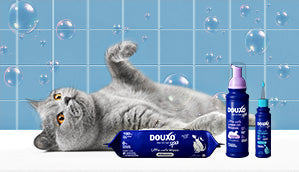
Skin parasites in cats
Parasites are small creatures which live on other animals, feeding on them and causing adverse effects – pretty unpleasant, really! External parasites – those which feed on the skin - are very common in cats.
Skin parasites are annoying, causing irritation, itching and sore skin and can lead on to further problems such as infections. Some parasites may even carry other diseases.
Maintaining a parasite-free existence for your pet requires careful coat maintenance and a dedicated treatment plan to keep them happy and healthy.

How cats get parasites
Parasites often have complicated life cycles, spending only part of their lives on an animal host. Some are contagious, with many jumping between animals (and humans!); while others can live successfully in the environment until a new host comes along.
Parasites can be seen in both indoor and outdoor cats for this reason, especially in modern homes with central heating and carpets where they can readily survive for long periods. Cats don’t develop immunity to these parasites, they can be recurrently infected and reinfected, so constant vigilance and maintenance is required to keep pets parasite-free.
What are the most common parasites?
Common external parasites in cats include fleas, ticks and mites. Cats can also get lice, but this is uncommon in healthy adults.
Fleas
Fleas are the most common external parasite seen on cats, causing itchy bites and scratching. Some cats are allergic to flea saliva, and react more severely, with inflamed, sore skin, itching and areas of hair loss (alopecia) and small red scabs (miliary dermatitis). This syndrome is often referred to a “Flea allergy dermatitis” or FAD for short.
Adult fleas live on the cat, and quickly multiply, with female fleas producing around fifty eggs daily. The eggs drop off the cat, and hatch into larvae around a week or two later, before cocooning into pupae.
The developed adult will wait inside the cocoon until a combination of signs (heat, carbon dioxide and movement vibrations) signal a new host cat may be approaching, when it then hatches and looks for a new victim. Modern homes unfortunately provide an ideal flea breeding ground, so your cat doesn’t even need to venture outside to be infected!
To make matters worse, fleas themselves are often infected with parasites – specifically, tapeworms. If the cat catches an infected flea while grooming, they will themselves become host to the tapeworm. This is why all cats with fleas should be treated for tapeworms as well.
Ticks
Ticks are small, blood-sucking creatures found most often in moorland, long grass and woodland. They attach to the cat via biting mouthparts. Ticks don’t seem to bother cats unduly, and don’t generally cause itching, but they can transmit disease.
When an animal such as a cat passes by, ticks jump on, climb up the legs and attach to their new host by biting them. They remain on the host, feeding on blood, for around five days before dropping off.
When they first attach, they are very small, but gradually grow up to 1cm in length, turning a grey-blue colour as they feed and engorge. Once full, the female can lay several thousand eggs which hatch into new tick larvae, ready to repeat the cycle in future years.
Mites
Mites are tiny parasites, only the largest of which are visible to humans (if you’re looking closely)! They are generally highly contagious, passing easily between animals via direct contact or in bedding and grooming equipment. Mites have life cycle which involves four stages: egg, larva, nymph and adult. The whole cycle takes around three weeks.
There are various types of mites which can affect cats, including ear mites, harvest mites and sarcoptic mites which cause mange. Ear mites live deep in the cat’s ear canal, causing a proliferation of waxy discharge and irritation.
Affected cats may scratch at their ears or shake their heads a lot. Harvest mites are seasonal, causing itchy discomfort to some cats in the late summer and autumn. Sarcoptic mange mites are less common in cats than dogs, but can cause scabby, irritated and itchy areas of skin. These burrowing mites are small and can only be seen under a microscope.

Detecting parasites in cats
It can be difficult to know if your cat has picked up any unwanted friends! You may see signs of itching, such as excessive scratching, licking or rubbing, but some cats will appear unaffected until they develop a very heavy parasite burden.
The best way to keep a close eye on your cat’s dermatological health is through regular grooming and examination of their skin and coat. Getting into the habit of a regular maintenance routine has many benefits: it’s a great bonding experience with your cat, leads to a well-maintained coat and it’s a wonderful chance to spot any problems early!
The wet paper test
Fleas are very speedy critters and can be hard to spot in amongst a cat’s fur. Stand your cat on some white paper and comb through with a flea comb. You may catch some adult fleas on the comb, but also check the paper for black specks of ‘flea dirt’. When placed on damp cotton wool or wetted white paper: flea dirt will show blood-red streaks.
Regular tick checks
Ticks can be seen with the naked eye or felt under fur with your fingertips. Comb and check your cat all over regularly for small lumps or bumps and carefully examine them. Removing ticks correctly is not always easy, and veterinary advice should be searched for advice before trying.
Mites are hard to detect.
Mites are super tiny and can be difficult to spot. Groom cats with a fine-toothed comb and look out for signs of skin discomfort such as reddened skin, scabs or scurf, hair loss (alopecia) or itching. Harvest mites can sometimes be seen as tiny orange specks on hairless or sparsely haired skin such as the ears and interdigital spaces.

Maintenance
There are plenty of safe and effective veterinary medications for the treatment and prevention of parasites, so chat to your vet about the best options for your pet. You may need to treat your home as well as your cat, as pets are regularly infected via the environment.
Your cat’s skin is their largest organ, and their first line of defence against many threats. Almost all cats will inevitably come into contact with parasites, whether they live indoors or out.
A regular grooming schedule and coat maintenance will keep your cat’s skin as strong and healthy as it can be. Some cats will be more sensitive to parasites than others, and keeping their skin barrier intact and their skin surface microflora well balanced is essential.
Topical products can also be used to promote balance and strength of the skin barriers for ultimate protection, as well as soothing skin affected by parasite infestations. Shampoos clean the skin and provide relief from irritation and itching.
Bathing & Grooming Tips
If your cat won’t tolerate bathing, mousses such as Douxo® S3 CALM Mousse can be massaged into the skin and left on to provide a prolonged effect.
Pads are also a convenient option for cats who have smaller areas of skin affected. Products in the DOUXO® S3 CALM range soothe irritated, itchy skin whilst balancing the skin’s natural balance of microorganisms.
If you’re looking for more expert pet skincare tips, why not explore our other articles online? And don’t forget, you can also sign up to our newsletter to receive all the latest news straight into your inbox!















